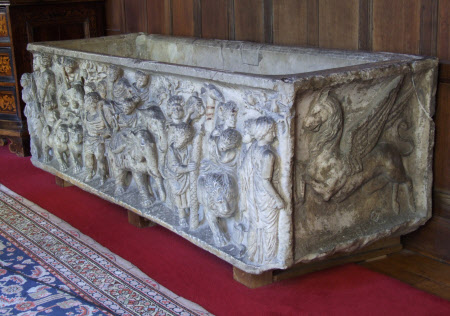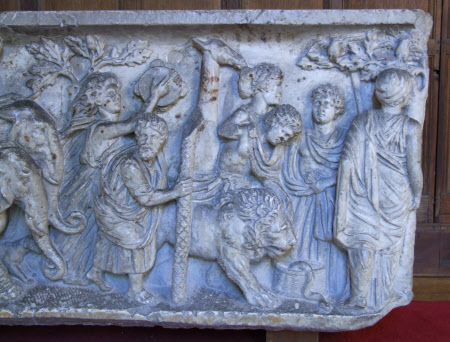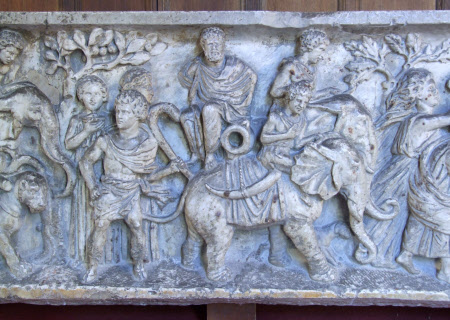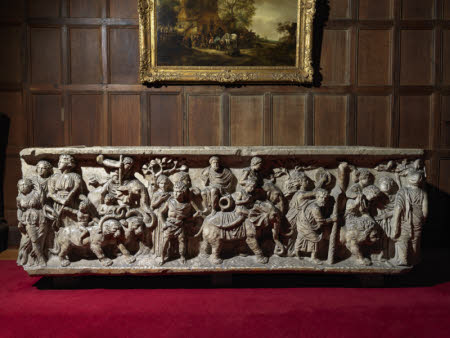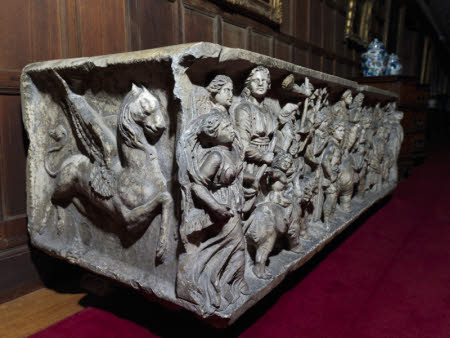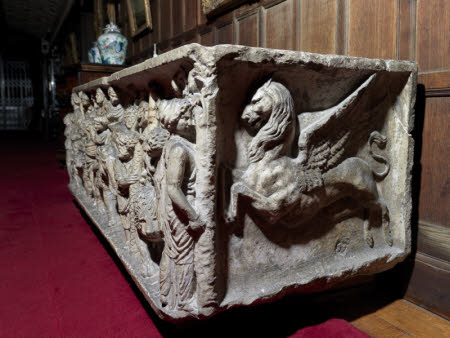Sarcophagus with the Triumph of Bacchus and griffins
Category
Art / Sculpture
Date
753 BC - 480 AD
Materials
Marble
Measurements
685 x 2180 x 760 mm
Order this imageCollection
Polesden Lacey, Surrey
NT 1246926
Summary
Marble, Sarcophagus with the Triumph of Bacchus, probably Roman with modern restorations. A marble sarcophagus with relief showing the triumphal procession of Dionysus/Bacchus through India. Bacchus at left, clutching his thyrsus (a type of staff associated with his cult), looking left, standing to the right of a winged Victory (Nike) and a dancing maenad. In front of him a pair of panthers or tigers attached by a yoke, each ridden by a male child. Behind the panthers an elephant is ridden by a satyr. At centre left the cloven-footed Pan holds a curved staff and stands before a woman holding a ?bird's nest. She stands below a ?quince/laurel tree. At centre a pair of elephants are ridden by boys, perhaps satyrs, draped in fawnskins; a male figure, facing, perches on the rear of one of the elephants, beside him a large vessel (krater). A tusk is strapped to the saddle one of the elephants. Another big cat is adjacent to the elephants. At centre right, before two oak trees, a maenad dances and beats a tambourine. An elderly male figure (?Silenus) clutches a thick-stemmed thyrsus. At right a giraffe and lion process around male and female figures; a snake slithers from a basket placed before the lion. Birds (?eagles or eaglets) perch in the far right oak tree. Each side panel is carved with a griffin facing towards the front.
Full description
While the marble sarcophagus is generally accepted to be antique, the age of its relief carving has been the subject of scholarly debate. In his 'Notes on a New Edition of Michaelis: Ancient Marbles in Great Britain' (1955), Cornelius C. Vermeule concluded that Polesden's relief was a 19th century variant of one carved on a Roman Imperial sarcophagus now in the collection of the Walters Art Gallery, Baltimore. That sarcophagus was excavated from the so-called Licinian tomb at Porta Pia, Rome, in 1885 (collection of Don Marcello Massarenti; subsequently purchased by Henry Walters, Baltimore, 1902 and bequeathed, in 1931, to the Walters Art Gallery, Baltimore, acc.no. 23.31). Comparing the two, Vermeule concluded that the relief on the Polesden sarcophagus was 'no doubt executed in Italy on an ancient sarcophagus' between 1885 and 1894, probably 'when the Baltimore sarcophagus and its companions were being renovated by the restorers' (Vermeule 1955, p. 146). In a 2001 article Dr Tom Rasmussen, by contrast, considered the Polesden sarcophagus and its relief to be contemporary with one another, that is to say third century (slightly later than the date of circa 190 CE given to Baltimore's). Rasmussen argued that while Dionysian Triumphal Sarcophagi imagery is likely to derive from a Hellenistic prototype, variations in the motif are probably owed to the individual stonemason's adaptation of cartoons or designs in pattern-books (Rasmussen 2001, p. 338). In his 2016 doctoral thesis Dr William Leveritt upholds Vermeule's assessment that the relief was carved in the late 19th century, on a plain Roman sarcophagus, in order to enhance its market value and appeal to 19th century collectors. Leveritt's conclusion is based on several comparative observations: the carving on Polesden's sarcophagus is markedly more shallow than Roman sarcophagi carving, which is typically in high relief in order that the images be visible by lamplight; the parallel chisel marks appear to be modern, i.e. not of the sort usually seen in the work of traditional Roman stone carvers; Dionysus, in the Polesden sarcophagus, appears to be missing his chariot, which is clearly present in the Baltimore; on this theme, features and figures essential to the Dionysian Triumph motif are either missing or misrepresented in the Polesden sarcophagus; finally, the style of the griffins carved onto the side panels are anomalous and, paradoxically, they are carved too deeply relative to typical Roman end panels.
Provenance
The bequest of Margaret (Anderson) McEwan, The Hon. Mrs Ronald - later Dame Margaret - Henry Fulke Greville, DBE (1863-1942) from probate records linked with the donation of the property to the National Trust in 1943. This item found on the record for Polesden Lacey The Corridor, page 9.
References
Vermeule, 1955: Cornelius C. Vermeule, ‘Notes on a New Edition of Michaelis: Ancient Marbles in Great Britain’, American Journal of Archeology, vol.59 (1955), pp. 129-150. Rasmussen 2001: Tom Rasmussen, 'Bacchus Triumphs on the North Downs: the Polesden Lacey Sarcophagus', in N.J. Higham (ed.), The Archaeology of the Roman Empire: A Tribute to the Life and Works of Professor Barri Jones, Oxford 2001, pp. 335-42 Leveritt 2016: William Leveritt, ‘Dionysian Triumph Sarcophagi’, unpublished doctoral thesis, University of Nottingham, 2016
